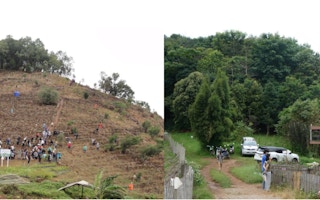On average, nearly half of the trees planted to restore tropical and sub-tropical forests do not survive more than five years, according to a study on the long-term outcomes of restoration projects. However, the survival rates varied greatly among sites and species, pointing to the need for taking the right approach tailored to local factors.
To continue reading, subscribe to Eco‑Business.
There's something for everyone. We offer a range of subscription plans.
- Access our stories and receive our Insights Weekly newsletter with the free EB Member plan.
- Unlock unlimited access to our content and archive with EB Circle.
- Publish your content with EB Premium.
The study, published in the Philosophical Transactions of the Royal Society B: Biological Sciences on Monday, analysed tree survival and growth data from 176 restoration sites in Asia, where natural forests have suffered degradation. It found that, on average, 18 per cent of planted saplings died within the first year, and the proportion rose to 44 per cent after five years.
Yet, at some sites, nearly 80 per cent of trees were still alive after five years, whereas a similar percentage had died at others. “The large variability in survival we found across sites could be for a number of reasons, including planting densities, the choice of species, the site conditions, extreme weather events or differences in management and maintenance. Local socio-economic factors may also be important,” Dr Lindsay Banin, co-lead author based at the UK Centre for Ecology & Hydrology, said.
It is important to understand what works and why, and share that information so as to bring all sites up to the level of the most successful and “harness the full potential for restoration”, Dr Banin said.
More experiments are needed to understand the most appropriate and cost-effective methods of restoration across sites under different conditions, the study adds.
Forests lock away carbon and support important habitats, and their restoration is key to arresting biodiversity loss and climate change. Reforestation projects are also used widely for carbon offsetting.
Most projects measure success by the number of trees initially planted, but the new research shows that many of these trees are not surviving long-term.
Southeast Asia is home to 15 per cent of the world’s tropical forests, which are among the most carbon-dense and species-rich in the world, housing tigers, primates and elephants. Rapid deforestation reduced Southeast Asia’s forest cover by an estimated 32 million hectares between 1990 and 2010, making the region a key focus area for forest restoration projects.
First study on long-term outcomes of restoration projects
The new research is the first to bring together data to evaluate the long-term outcomes of restoration projects, which are gathering speed and scale thanks to global efforts such as the UN Decade on Ecosystem Restoration, the Glasgow Leaders’ Declaration on Forests and Land Use and Tropical Forest Alliance. Forests’ role as carbon sinks and their potential for carbon offsets have also made restoration projects more attractive.
However, as co-author Prof Robin Chazdon of the University of the Sunshine Coast, Queensland, Australia, points out, replanting trees is only useful if they survive long enough to draw in and lock away carbon, and projects have to be able to quantify their carbon-locking potential and the timescales involved. “This is why assessing restoration outcomes over the long-term, and gathering information that helps to maximise success rates, are so important. We need the focus to shift away from simply planting trees toward growing them and helping our forests thrive.”
Where reforestation was more successful
The team of scientists from 29 universities and research centres found that reforestation efforts were less successful in fully deforested areas than in areas where some trees remained. Saplings planted in areas with existing mature trees had roughly 20 per cent higher chance of survival. In more disturbed areas, more intensive measures to protect and maintain the saplings may be needed, the study says.
“The sites where active restoration is most needed – those that have already been cleared of trees – are also those where restoration is most risky and prone to higher numbers of trees dying,” said Prof David Burslem, co-author based at the University of Aberdeen in the UK. “We need to understand better how to improve the survival chances of saplings on these sites, to ensure restoration has positive outcomes.”
Overall, the study says, active restoration provides faster results – sites where trees were planted gained forest cover more quickly than those left to regenerate naturally.
Among the studies that the present research worked with, many more tracked the fate of individual trees rather than how well the forest overall had regenerated. The research team say that collating both types of data will help understand how many trees need to survive in a particular site to achieve successful restoration.
The study also provides a warning, Burslem said, to protect remaining forests as much as possible, both because restoration outcomes are uncertain and to provide the diverse seed sources needed for forest restoration.








